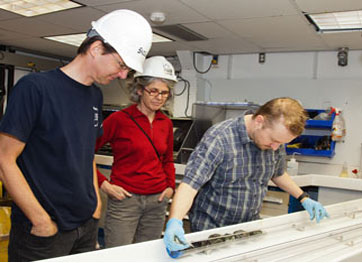Expedition Yields Unexpected Clues to Ocean Mysteries
UH Geoscientist Jonathan Snow Leads International Drilling Mission to Lower Crust
of Pacific
Co-chief scientists Jonathan Snow and Kathryn Gillis observe as curatorial specialist
Chad Broyles works on a core sample in the splitting room. (Photo credit: Bill Crawford,
IODP/TAMU)A University of Houston (UH) geoscientist and his colleagues are revealing new discoveries
about the Earth's development, following a major international expedition that recovered
the first-ever drill core from the lower crust of the Pacific Ocean.
Co-chief scientists Jonathan Snow from UH and Kathryn Gillis from University of Victoria in Canada led a team of 30 researchers from around the world on the $10 million expedition, finding a few surprises upon penetrating the lower crust of the Pacific. Their findings are described in the Dec. 1 issue of Nature in a paper titled "Primitive Layered Gabbros from Fast-Spreading Lower Oceanic Crust."
"The ocean crust makes up two-thirds of the Earth's surface and forms from volcanic magma at mid-ocean ridge spreading centers," Snow said. "The deepest levels of this process are hidden from view due to the miles of upper volcanic crust on top. So, until now we had to make educated guesses about the formation of the lower crust based on seismic evidence and the study of analogous rocks found on land."
Window into Lower Crust of Ocean
Traveling aboard the Integrated Ocean Drilling Program Expedition 345 to the Hess Deep in the Pacific Ocean, the scientific voyagers recovered core sections of lower crustal rocks, called gabbros, that formed more than two miles beneath the sea floor. A large rift valley in the eastern equatorial Pacific, the Hess Deep is like an onion sliced and pulled apart, revealing its deeper layers.
"Hess Deep is like a window into the lower crust of the ocean, where we can drill directly into these lower crustal levels," Snow said. "This is where magma rising up from the Earth's mantle begins to crystallize on its way to eventual eruption at the sea floor."
The two-month expedition, aboard the drilling vessel JOIDES Resolution, confirmed for the first time the widespread existence of layered gabbros in the lower crust. This observation had been predicted by plate tectonic theory and analogies made to fragments of ocean crust found on land, called ophiolites, but only rarely had actual layered rocks been recovered from the ocean floor.
Expedition Yields Surprises
A second surprise discovered by the explorers was akin to "finding gold in a silver mine," according to Snow. By studying thin slices of the gabbros under polarizing microscopes, the scientists identified substantial amounts of the mineral orthopyroxene, a magnesium silicate that was thought to be absent from the lower crust.
"Orthopyroxene by itself is nothing special. Traces of it are often found at late stages of crystallization higher in the crust, but we never in our wildest dreams expected a lot of it in the lower crust," Snow said. "Although this mineral is not economically valuable, the discovery means that basic chemical reactions forming the lower crust will now have to be re-studied."
A third surprise, Snow says, casts doubt on one of the main theories of the construction of the lower ocean crust. It involved the mineral olivine, also a magnesium silicate. This mineral is known to grow in delicate crystals sometimes found in layered intrusions on land, but never expected in the ocean crust. This is because the separation of the tectonic plates was thought to deform the magma like play dough in a partially molten state that would have broken them up. However, Snow says, the last word isn't written on this, because the researchers just cored a small section of the crust in one place on this expedition. To know for sure, they will have to explore the lower crust more, which will require drilling.
The fourth phase of ocean drilling, to be called the "International Ocean Discovery Program," was approved in late November by the National Science Board (NSB). The NSB is the governing board of the National Science Foundation and is responsible for guiding the pursuit of national policies for promoting research and education in science and engineering.
The paper is online at http://www.nature.com/nature/journal/vaop/ncurrent/full/nature12778.html.
- Lisa Merkl, University Communication
